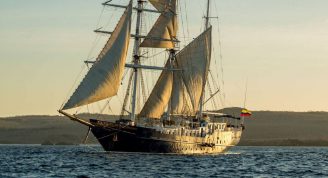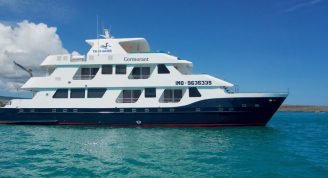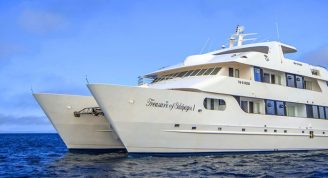Description
Our 6 night-route runs around the largest, seahorse-shaped island of Isabela, where nature seems to hunt for the greatest. Explore the virtually untouched western end of the Galapagos Islands, which has just been born out of fire. You are right on time for the first thrilling chapters of evolution! Uncover the mystery of how tough pioneer species make barren lava fields habitable; and approach bizarre outgrowths of adaptation as marine iguanas and flightless cormorants. It’s true that accessing this remote and isolated region demands longer navigation (mainly overnight), but our stable mega-catamaran enables you to witness ‘survival of the fittest’, without experiencing it.
Trip Name
Galapagos 7 Day Route C aboard Treasure of Galapagos
Days
7
Overview
Vessel Type: Motor Catamaran
Passenger Capacity: 16
Length: 31.6 m
Built: 2009
Welcome to the Galapagos aboard our stable motor catamaran
Our stable seaworthy catamaran is considered one of most intimate cruise options at present for the Galapagos Islands. It is the perfect choice if you appreciate private comfort or if you dread seasickness; whether travelling on your own or for your romantic getaway! The inviting ambience of your comfortable cabin with inspiring sea views, and a maximum number of only 16 international guests, may turn your naturalist cruise into a personal experience.
Bringing nature even more to life
Without doubt your on-board naturalist guide is the crucial pivot for your experience in the Galapagos. Being a first-class yacht, Treasure of Galapagos contracts only the best National Park certified guides (Class III or II). Our experts use their extensive experience to lead the excursions, to search and identify species and point out interesting details; besides taking care of your safety and compliance of indispensable conservation rules.
Above all our guides share their knowledge, love and respect for the Galapagos’ stunning ecosystem. Their inspiring explanations (in English and Spanish) and fascinating stories about animal behaviour, intriguing ecosystems and survival strategies can bring nature even more to life; not only in the field, but also during lectures or daily briefings aboard. Of course you can consult your guide for personal questions or just to share your curiosity.
Enjoy a more intimate nature experience
Small groups definitely make your nature and cruise experience more intimate and profound. Thanks to a maximum number of only 16 passengers aboard M/C Treasure of Galapagos, your naturalist guide can easily respond to different individual interests. You can also hear him/her loud and clear in the field.
Both our smaller inflatable dinghies (‘Zodiacs’ for only 8 passengers each) make boarding and disembarking our catamaran much faster, and increases your chances to spot wildlife during dinghy-rides. On larger expedition vessels different groups have to keep a certain distance, and lose flexibility and valuable excursion time on the islands.
Specially designed for First Class Galapagos cruising
This modern First Class yacht was built in 2009 and is well maintained (dry dock every second year).
It is equipped with two powerful engines that give a cruising speed of 9 knots (over 22 km/h; 13.5 mp/h). The crew’s quarters, kitchen and engines are hidden inside both hulls (Lower Deck).
All this makes Treasure of Galapagos not too large to become impersonal, and not too small to feel trapped without comfort.
Leisure time in an inviting private ambience
Your impressive cabin resembles a floating hotel room with an ample bathroom, private balcony, sitting area, ample storing space, soft carpeting and regular beds.
This inviting private ambiance with inspiring sea views is an ideal place to withdraw for a while, after another impressive excursion (in contrary to common cramped and dark cabins with just a porthole and berths/bunk beds). You may easily forget the cosy living room and deck terraces with comfortable deck chairs and our hot tub!
Delicious food: to make your mouth water
Our professional cook and kitchen staff will treat you to a substantial breakfast, and mouth-watering warm lunches and dinners, all served in abundant buffet style.
The galley (kitchen) will keep surprising you with a varied menu of local and international dishes with at least two choices (usually fish, chicken or meat), rice/potatoes/pasta and various vegetables and salads.
Our food is healthy and delicious; special meals (vegetarian or other dietary requirements) are available upon previous request at no extra cost. Snacks and juices are served in-between meals.
Meanwhile our captain navigates safely to the next destination
Whilst carelessly enjoying the leisure ambience on-board, you can be rest assured that the captain and his competent crew continuously look after your safety on-board. They are always there to help you in and out safely when boarding and disembarking, or driving the inflatable dinghies (‘Zodiacs’) carefully.
Many zones of the Galapagos are near the end of the world and request self-sufficiency. As a matter of course all crew-members have first-aid knowledge.
Your naturalist guide and captain are trained to deal with eventual medical or other emergencies aboard. The bridge always maintains radio contact with the outside world.











